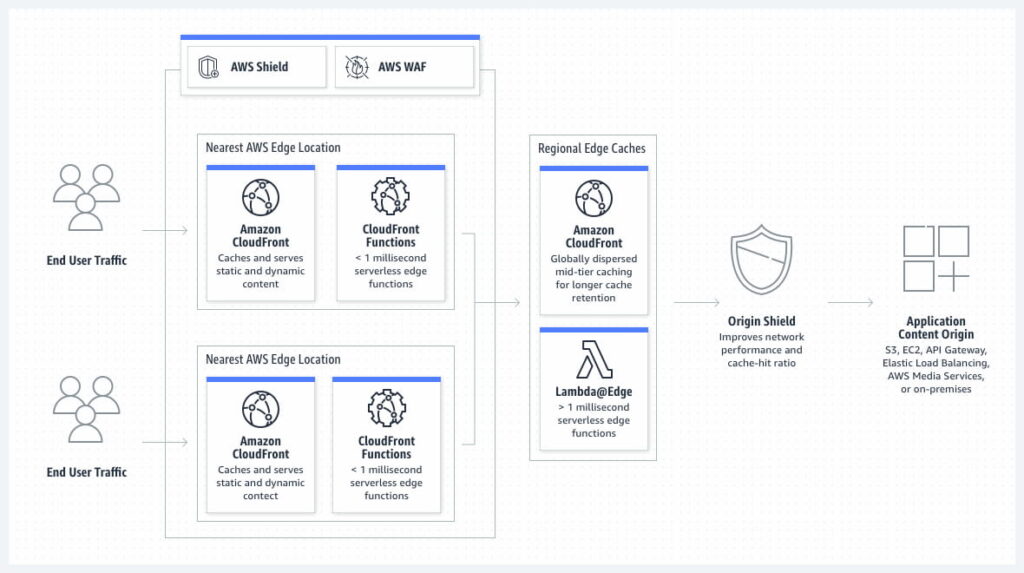In the world of cloud computing, Amazon Web Services (AWS) has established itself as a leader, offering a wide range of services to help businesses thrive in the digital realm. One such service is AWS CloudFront, a content delivery network (CDN) that accelerates the delivery of websites, videos, and other web content to users around the world.
Navigating the pricing options of AWS CloudFront can be complicated, which can leave businesses unsure of how to optimize costs and performance. But don’t worry, we’re here to simplify AWS CloudFront pricing and give you the knowledge you need to make informed decisions.
This guide breaks down AWS CloudFront pricing, explains how it affects your costs, and offers tips to save up to 90% off standard CloudFront rates!
Table of Contents
What is Amazon CloudFront and Why You Should be Using It
Amazon CloudFront, part of Amazon Web Services (AWS), is a content delivery network (CDN) designed to deliver data, videos, applications, and APIs globally with low latency and high transfer speeds. It integrates with other AWS services, offering a suite of customization options and advanced security features such as AWS Shield, AWS Web Application Firewall (WAF), and DDoS mitigation. This ensures secure, efficient, and reliable content delivery, enhancing user experience and data integrity.
Utilizing CloudFront is essential for businesses seeking to optimize content delivery, improve user satisfaction, and manage costs effectively. Its pay-as-you-go pricing model and seamless integration with services like Amazon S3 and Lambda@Edge make it a scalable and affordable solution for businesses of all sizes.

Understanding AWS CloudFront Pricing
To truly optimize costs and maximize performance with AWS CloudFront, it’s crucial to comprehend its pricing structure. The primary cost components are data transfer and requests. Data transfer encompasses the data moved from the origin server to CloudFront edge locations, and requests denote the number of HTTP/HTTPS requests made to CloudFront. It’s important to note that AWS CloudFront operates on a pay-as-you-go model, which offers the flexibility to scale usage based on needs, without upfront costs or long-term commitments.
Factors that Affect AWS CloudFront Costs
- Data Transfer Volume: The quantity of data transferred significantly impacts CloudFront costs. Higher data transfer volumes lead to increased expenses. To manage this, it’s essential to examine your data transfer habits and pinpoint areas for improvement. Strategies might include downsizing file sizes or adopting caching methods to optimize data transfer.
- Number of Requests: Each HTTP/HTTPS request to CloudFront incurs a cost. To control expenses, it’s vital to limit unnecessary requests. This can be done by employing effective caching solutions, refining your website or application’s code, and using CloudFront features like Lambda@Edge for request modification.
- Data Transfer to Origin: Costs associated with transferring data from CloudFront back to the origin server are termed “Regional Data Transfer Out to Origin.” These charges are calculated per GB and vary depending on the region.
- Price Class: The “Price Class” selection in CloudFront also affects costs. Price classes allow you to lower delivery prices by excluding some of CloudFront’s more costly edge locations from your distribution. There are different classes:
- Class 100: Includes only EU and US edge locations.
- Class 200: Adds additional locations in South America, the Middle East, North Africa, Japan, and India.
- Default (All) Class: Encompasses all available regions.
For a detailed breakdown of costs, it’s advisable to review the AWS CloudFront pricing page and the AWS documentation.
Optimizing AWS CloudFront Costs
Now that we understand the factors that affect AWS CloudFront pricing, let’s explore some strategies to optimize these expenses.
Leveraging CloudFront’s Pricing Tiers
Another strategy to optimize costs is to leverage CloudFront’s pricing tiers. AWS CloudFront offers different pricing tiers based on the amount of data transferred and the number of requests made. By carefully analyzing your usage patterns and selecting the appropriate pricing tier, you can ensure cost efficiency without compromising performance.
Regular Monitoring and Analysis of Costs
Furthermore, it’s crucial to monitor and analyze your AWS CloudFront costs regularly. AWS provides detailed billing and usage reports that can help you identify cost optimization opportunities. By regularly reviewing these reports and implementing necessary adjustments, you can stay on top of your costs and make informed decisions.
Choosing the Right AWS CloudFront Pricing Plan
AWS CloudFront pricing presents two primary options: on-demand and the CloudFront Savings Bundle. On-demand pricing is ideal for businesses with variable traffic or unpredictable usage, charging only for the resources used with no upfront commitments.
CloudFront Savings Bundle: A Smart Commitment
The CloudFront Savings Bundle is a boon for businesses aiming for cost efficiency without compromising on performance. By committing to a one-year term, you unlock a 30% discount on your CloudFront bill, merging affordability with the robust content delivery CloudFront is renowned for. This bundle is tailored for enterprises with consistent workload patterns, making it a prudent choice for long-term cost optimization. The upfront commitment is balanced by substantial savings, making it a lucrative option for cost-conscious businesses. Embrace the CloudFront Savings Bundle, and propel your digital content delivery onto a cost-effective trajectory. For more details, visit the AWS documentation.
Performance Considerations for AWS CloudFront
While optimizing costs is important, it should not come at the expense of performance. AWS CloudFront is designed to deliver content with low latency and high availability. To ensure optimal performance, there are several considerations to keep in mind.
Leveraging Origin Shielding and Failover
Consider leveraging CloudFront features like origin shielding and origin failover. Origin shielding helps protect your origin server from receiving excessive requests by routing traffic through an intermediate cache layer. Origin failover, on the other hand, ensures high availability by automatically routing traffic to a backup origin server in case of failures.
Configuring Efficient Caching and TTL Values
It’s essential to properly configure caching headers and TTL (time-to-live) values. By setting appropriate caching parameters, you can ensure that content is cached efficiently at the edge locations, reducing the need for frequent origin server requests and improving performance.
Monitoring and Analyzing AWS CloudFront Costs and Performance
To effectively optimize costs and maximize performance with AWS CloudFront, it’s crucial to monitor and analyze your usage patterns. AWS provides various tools and services to help you gain insights into your CloudFront costs and performance.
One such tool is AWS Cost Explorer, which allows you to visualize and analyze your AWS costs over time. With Cost Explorer, you can identify cost trends, set cost and usage budgets, and receive cost forecasts, enabling you to make informed decisions and optimize your expenses.
Additionally, AWS CloudWatch provides monitoring and alerting capabilities for your CloudFront distributions. By setting up CloudWatch alarms, you can be notified of any performance issues or anomalies, allowing you to take proactive measures and ensure a seamless user experience.

We Love Startups (and They Love Us Back!)
Our team has a proven track record of helping 700+ startups, just like yours. As an official Scout for the AWS Activate program, we have the perfect mix of tools to maximize your project’s potential on AWS.
Our team takes pride in building strong relationships with our clients, allowing us to continue supporting their growth for years to come.
Best Practices for Cost Optimization and Performance Enhancement
To achieve optimal cost efficiency and performance with AWS CloudFront, here are some best practices to follow:
- Leverage CloudFront cache behaviours and cache-control headers to fine-tune caching rules.
- Analyze your usage patterns and select the appropriate pricing tier or CloudFront security savings bundle.
- Regularly monitor and analyze your AWS CloudFront costs and performance using tools like AWS Cost Explorer and CloudWatch.
- Optimize your content for delivery by compressing files, minimizing redirects, and leveraging HTTP/2.
- Use CloudFront features like Lambda@Edge for advanced request manipulation and customization.
- Consider implementing origin shielding and origin failover for improved availability and performance.
- Work with an advanced-tier AWS partner, like Cloudvisor, to receive exclusive discounts on CloudFront.
Save Big on CloudFront with Cloudvisor
As an advanced-tier AWS partner, we can help startups like yours save on AWS services, including CloudFront. Cloudvisor can offer you at least a 50% discount on your CloudFront bill based on your usage, with the possibility of up to 90% off. The best part is that the more you use CloudFront, the higher the discount you can receive!
We’ve already assisted over 500 clients in maximizing their AWS benefits, and we’re ready to do the same for you. Don’t hesitate to contact us!







